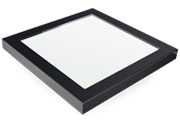How to Choose the Right Skylights for Your Home
Want to brighten up your home? Skylights could provide you with the ideal solution. In addition to bringing natural light into your home, skylights will help you to reduce your dependency on artificial lighting, enabling you to save money and reduce your carbon footprint.
Whether you are looking to brighten up your kitchen, hallway, living room or loft conversion, you will need to choose the best skylight for your needs. Here are just a few of the considerations you will need to make before purchasing a skylight for your home.
Sizes
The physical size of your skylight will have an impact on the illumination level and temperature of the room in which it is installed, so choosing wisely will help you better control the level of light and heat coming into your home. Contrary to popular belief, bigger skylights are not necessarily better. When installed in a suitable position, a small skylight will be able to brighten your room with ease.
You may also like to consider stock sizes which are often more cost effective and will benefit from shorter lead times.

Design
Firstly you will need to decide whether you require an opening or fixed version. An opening or vented skylight will enable you to let more air into a room whereas a fixed version is used where more light is required.
For more information on the different skylight options on the market, you can use our rooflight for flat roofs product selector.

Location
If you wish to maximise daylight coming into your home, you will need to consider your skylight’s position. Skylights on north-facing roofs will provide you with fairly constant but cool illumination. Those on east-facing roofs will provide maximum light and heat gain in the morning, whilst those on west-facing roofs will provide this in the afternoon. Skylights on south-facing roofs will offer the greatest potential for desirable winter heat. However, they can occasionally generate unwanted heat gain during the summer months. In this instance a solar reflective glass option or internal blind may be a consideration.
Insulation
 Advances in skylight design and manufacturing have significantly reduced any issues which allow heat to escape from your home. This loss is measured by the term U-value, so the lower the U-value of your chosen skylight, the better the insulation it will provide. Where possible you should aim for U Value of 1.2 WmK or under, ask your supplier to provide a copy of their test results to confirm that there products are as efficient as they say. Remember a glass center pane U value is not the same as the product U Value, providing a glass U Value is a little trick used in the industry to make products appear more efficient that they actually are.
Advances in skylight design and manufacturing have significantly reduced any issues which allow heat to escape from your home. This loss is measured by the term U-value, so the lower the U-value of your chosen skylight, the better the insulation it will provide. Where possible you should aim for U Value of 1.2 WmK or under, ask your supplier to provide a copy of their test results to confirm that there products are as efficient as they say. Remember a glass center pane U value is not the same as the product U Value, providing a glass U Value is a little trick used in the industry to make products appear more efficient that they actually are.
Cost
The cost of your skylight will depend on the type, quantity and size you choose and the complexity of the installation. Bear in mind that large rooflights can be more cost effective compared to multiple smaller skylights, but installation costs may increase and in some instances specialist lifting equipment be required. Modular Rooflights can be a stylish way to glaze a large area while keeping the sections smaller and more manageable means that the install is a far simpler process.
These tips should give you a good idea of the considerations needed in order to choose the best roof light for your home. Here at EOS Rooflights, we can provide you with a bespoke package to suit your needs. If you want to find out more, get in touch today or take a look at our Fixed Rooflights, Opening Rooflights, Triple Glazed Rooflights, WalkOn Rooflights, Modular Rooflights, Circular Rooflights or Access Rooflights pages for more information and to see our stock sizes and product information.
Contact our team
If you have any questions, would like a bespoke price or want to enquire about our installation service. Give us a call or drop an email:
![]() 0208 462 3557
0208 462 3557



